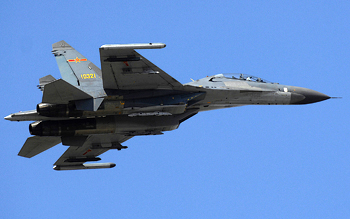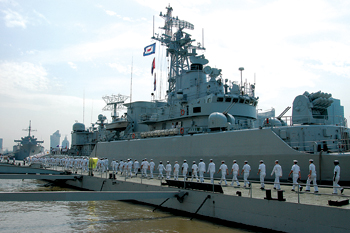INDIAN ARMED FORCES CHIEFS ON
OUR RELENTLESS AND FOCUSED PUBLISHING EFFORTS

SP Guide Publications puts forth a well compiled articulation of issues, pursuits and accomplishments of the Indian Army, over the years

I am confident that SP Guide Publications would continue to inform, inspire and influence.

My compliments to SP Guide Publications for informative and credible reportage on contemporary aerospace issues over the past six decades.
- Prime Minister witnesses 'Bharat Shakti' – a Tri-Services Firing and Manoeuvre Exercise in Pokhran, Rajasthan
- Interim Defence Budget 2024-25 — An Analysis
- Union Defence budget 2024
- Prime Minister Modi Commemorates Indian Navy Day in a Grand Ceremony
- Prime Minister Modi Flies in the LCA Tejas
- New Chapter in India-Italy Defence Ties
- Airpower beyond Boundaries
Chinese defence budget - increasing asymmetry

Much that we may avoid the issue, the PLA is far ahead throughout the spectrum of conflict: nuclear, conventional, subconventional and cyberspace. And these asymmetries will be widened further with the steady doubledigit increase in the defence budget.
China’s massive defence budget 2015, pegged over $144 billion (about 890 billion RMB) with an increase of 10.1 per cent over the previous year, should be of concern to us. It may be safely assumed that if this is the official Chinese announcement, the actual figure would easily be around $200 billion or more considering the People’s Liberation Army’s (PLA) business empire. In addition to this is colossal amounts of money (other than the defence budget) that China is investing through development initiatives, particularly on port projects ringing the Indian Ocean region for strategic aims, which boil down to creeping forward deployment of the PLA since all such projects are either through PLA owned or PLA affiliated companies and more importantly have PLA presence as overseers, advisors, technicians, workers in the garb of civilians.


With respect to the incident on the China-Myanmar border, he stated that PLA border defence troops have increased the frequency of border patrols, set up more sentry posts, and beefed up control and management in the important passages and sensitive areas in addition to PLA Air Force (PLAAF) strengthening air situation monitoring in China-Myanmar border area and conducted emergency response to safeguard the sovereignty of China’s territorial air. Referring to the continuing double-digit increase in the Chinese defence budget, Chinese scholars maintain that the defence budget is no longer tied to economic performance and that defence spending is ‘sacrosanct’ and ‘untouchable’. Such policy is authenticated since China has gone ahead with a 10.1 per cent increase in defence spending despite the fact that her economic growth is unlikely to cross 7 per cent. They attribute this to political decision ‘across the board,’ but then dissent would hardly be tolerated with CCP’s hold through every echelon and Mao’s legacy dictum that power flows from the barrel of the gun.
Interestingly, external voices supporting increase in China’s defence budget came from Cambodia where in addition to scholars voicing support, Phay Siphan, spokesperson for Cambodia’s Council of Ministers, stated, “The rise (Chinese defence budget 2015) is reasonable and in line with China’s defence needs. There is nothing strange about this.” But it is well known that the Chinese investments in Cambodia and Laos have been massive to the extent of buying their opinion within the ASEAN. For India, the increase in China’s defence budget needs to be viewed in the backdrop of A.K. Antony’s decade as Defence Minister where forget the lull in modernisation, there was regression to the extent that even former diplomats remarked that the military had been brought down to the level of 1962 asymmetry with the PLA. Our defence-industrial complex remained comatose, laced with endemic inefficiency and corruption. The result today is that with glaring voids in inventories, it is officially acknowledged that 50 per cent of equipment holdings of our military are obsolete. This in addition to CAG reports pointing out that 30 per cent of indigenous defence equipment provided to the military by the DRDO-DPSUs-OF is substandard.
Much that we may avoid the issue, the PLA is far ahead throughout the spectrum of conflict; nuclear, conventional, subconventional and cyberspace. And these asymmetries will be widened further with the steady double-digit increase in the defence budget. China successfully test flew a hypersonic vehicle last year and has introduced stealth fighters, stealth UAVs, helicopters, vessels and submarines are to follow. China aims parity with the United States in science and technology in three decades. Compare this with our taking 15 years to develop the INSAS assault rifle that is nowhere near the top 10 in the world, the decades taken to develop the yet to be inducted Tejas aircraft, 31 years after Project Akash was sanctioned in 1984 news coming in that Army may get it finally albeit an interim model rejected in Army trials was simply dumped onto the Air Force to beef up point and aread air defence. These are just few examples. We are minnows in cyberspace compared to the PLA and nowhere in electromagnetic warfare while PLA has been training 600 personnel in this type of warfare since past three years. China’s 24 x 7 surveillance across the borders, designs on the IOR and deployment of missiles in Gilgit-Baltistan, and increasing offensive capabilities provide her the wherewithal for adventurism and brinkmanship against us.
Revolution in Military Affairs (RMA) was ushered into the PLA by Jiang Zemin and continues to be overseen by the CGS of PLA. The term would be foreign to our concerned polity and generalist and unaccountable bureaucrats of the Ministry of Defence (MoD). Despite the hype that our China Study Group consults the Services results on ground show we are unable to even read the strategic intentions of China. The last NSA speaking at Harvard recently never went beyond the hunky-dory policy of the previous government despite serious Chinese intrusions, intrusions and nibbling away some 645 sq km of our territory in Ladakh alone as brought out through the Shyam Saran Report. Confusion within our government ministries is apparent. Two years back, the NSCS warns against electronic equipment of Chinese companies Huwei and ZTE because of their links with PLA and possibility of embedded vulnerabilities in but within four months the Ministry of Home Affairs (MHA) opened the doors for them in India. Presently, the Ministry of External Affairs (MEA) has announced visa on arrival for Chinese nationals amidst protests by MHA; China need not now smuggle individuals with fake Indian identity across the LAC to meet insurgents in northeast. The question is will this government continue to ramble along in a manner similar to earlier ones or take stock of the situation and act; review defence allocations; remodel higher defence structures and the MoD plus the defence-industrial complex bringing in military professionals; define a national security strategy and national security objectives; order a comprehensive defence review; and, establish credible deterrence against proxy war? Not doing so will be at our peril.





